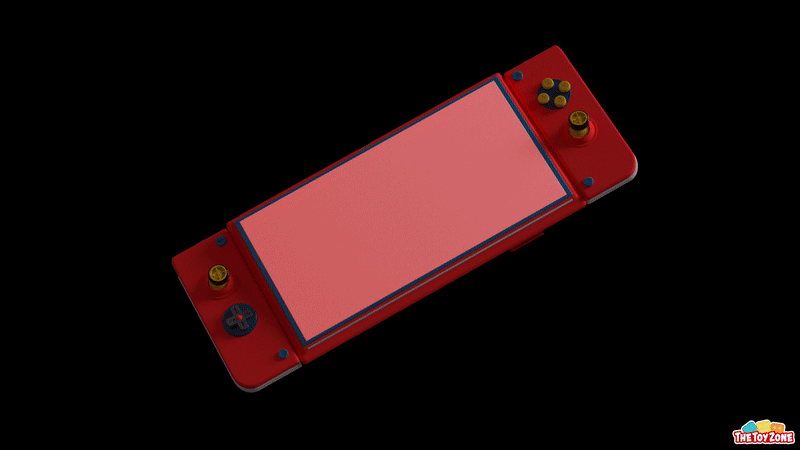Nintendo is the Napoleon Dynamite of games consoles: never trendy, but always iconic.
Boxy, big-hearted, and eager to please, Nintendo succeeds because its designers try so hard.
Right now, the company that defined home video gaming is teasing us with rumors of a powerful new follow-up to the Nintendo Switch. The Nintendo Switch Pro – as it may or may not be called – might or might not have a higher-resolution OLED screen, better controls, and a bigger engine than its predecessor.
Among Nintendo’s many design philosophies is one that we at TheToyZone particularly like: “lateral thinking with seasoned technology” – the idea that there are many exciting new things to be done with pre-existing ideas (such as reimagining video game weapons as Nerf blasters). We are massive fans of both the console and Switch games so this gave us an idea…
Keep scrolling to see eight concept designs for the new Nintendo Switch we produced, based on seasoned Nintendo designs of the past: classic consoles and iconic games that deserve their own special-edition Switch.
The NES Switch
Now you’re playing with power – the power to get up and go. The Nintendo Entertainment System was the western version of Nintendo’s hit Famicom console in Japan, and both of these made home gaming big in their respective regions. But you still needed Nintendo’s portable Game & Watch if you wanted to play away from a power socket – until now!
You don’t have to be an 80s kid to recognize the NES aesthetic. That passion for right angles. That clunky feel. That cold, loveless gray that says, “this isn’t a toy. It’s an Entertainment System.”

The SNES Switch
The SNES was Nintendo’s 1990s machine. In an era when fashionistas shed their shoulder pads, the Super Nintendo Entertainment System shed (some of) its sheer corners and even dabbled with colored buttons. This curvier, organic feel saved the SNES from looking dated next to the sleek Sega Mega Drive, which it soon outsold.
But North Americans got a rough deal: Nintendo’s US design team chose to keep the SNES boxy so that it could stack neatly beneath future devices. TheToyZone prefers the Japanese/PAL region’s ‘little bone’ shape for our Super Switch.

The Nintendo 64 Switch (aka. The “Switchty-Four”)
While other consoles were making the leap to 32 bits, Nintendo made a major selling point of achieving the big sixty-four. They also added 3D graphics and an analog stick (rather than an 8-way D-Pad), which shows how serious the 90s console wars had become.
Nintendo is famously secretive about its new designs. The trident shape and fin-like handles of the controller were elements of a radical new direction. To keep the new design secret, developers had to test their games with the controller hidden in a cardboard box that had holes cut out to put their hands through.

The Game Boy Switch
The Game Boy was a cyberpunk statement: with this and your Sony Walkman, you could always be connected to your personal media world. It was the first mobile console with interchangeable game cartridges, and the gateway device to gaming for many 80s and 90s kids.
By keeping that serious gray machine (not a toy!) permanently in your hands, you would soon dye it a special shade of grubby. But the Game Boy kept working and working: with just four buttons and unashamedly brick-shaped, one Game Boy even survived 196 days in outer space. TheToyZone reckons the original Game Boy and our Switchy Boy are far better-looking than this real-life designer Game Boy/Switch mash-up.

The Gamecube Switch
Nintendo went ‘full boxy’ with the Gamecube, its iMac-inspired successor to the N64. The shape and multiple color options showed an uncharacteristic effort to make the Nintendo seem ‘toy-like’. The company wanted top developers to create amazing games for their machines, and the simple, geometric Gamecube design invited playfulness.
The indigo Gamecube was the device’s flagship. It looks weirdly dated today, rather than retro. The Gamecube didn’t sell as well as other Nintendo consoles, perhaps because its main USP was its shape rather than its power or utility. However, the Gamecube will soon be two decades old, and it’s sure to acquire a vintage aura in the 2020s.

The Mario Kart Switch
It’s not just the consoles that are boxy. With Super Mario and its infinite spin-offs, Nintendo perfected an 8-bit aesthetic that prevails even through successive hardware boosts. With a limited color palette and limited curves, you know it’s Mario.
“When we first drew [Mario] in Donkey Kong, he was drawn using pixel dots in a 16×16 grid,” explains the franchise’s creator, Shigeru Miyamoto. “In order to emphasize the unique characteristics of the character, we made the big nose and the mustache and the overalls to make it easy to understand what the character was doing on the screen.”

The Star Fox Switch
While not a household name, Star Fox (aka Starwing/Lylat Wars) was the first accelerated 3D game on a console, and its N64 version was the first to use the Rumble Pak. The early 3D aesthetic and anthropomorphic animal heroes lend it a kitsch aura, altogether making Star Fox a cult classic.
Those jutting polygons also make for a unique Switch outline – a jaunty new take on Nintendo’s boxy heritage, and a throwback to our angular hero, Fox McCloud. “[His] first-generation face was a little weird,” says Miyamoto. “But, as the hardware progressed, little by little he became a cool fox!”

The Foldable Switch
This is the dawn of foldable screens, and it won’t be long before snotty kids can scrunch up their portables and stuff them in their pockets with whatever else they keep in there. To keep our foldable Switch concept Nintendo-esque, we looked to the clamshell designs of the Nintendo DS and Gameboy Advance SP for inspiration.
The DS had two screens, one of which was touch-sensitive. In the age of origami screens, we’ve put a smaller window on the outside for gaming in confined spaces, and a bigger, folding touch screen in the shell to fit in more platforms or even a keyboard.

Seasoned Tech Innovators
It seems like everybody in the gaming community has something to say about what the Nintendo Switch Pro design will be like. But Nintendo thrives on being one step ahead of the crowd – so we won’t know for sure until we’ve got it in our hands.
“In the industry of fun, I think there’s still a lot we can still explore,” as Shigeru Miyamoto says. “I think what I want to accomplish is kind of laying down the standards for what those possibilities are going to be over the next 10 years.”
FAIR USE STATEMENT
Do you love these Nintendo Switch Pro console concepts so much that you would like to republish them? That would be awesome! All we would ask for is that you credit TheToyZone by linking back to this page. That way your readers can learn about the work we do here at TheToyZone and explore other cool projects we produced, whilst our team gets rightfully recognized for their work.

Be sure to check out our printable mario coloring pages that we commissioned.













